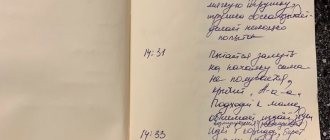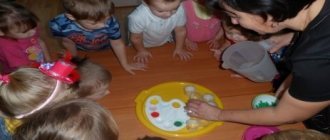The work of a kindergarten teacher requires clear and competent planning of the entire educational and educational process. In this case, it is necessary to take into account many different factors, including the specifics of each age of pupils, the level of learning and attentiveness of a particular child, the need to use a large number of different methods of education and training within one day. In this case, a cyclogram of the activities of a preschool teacher according to the Federal State Educational Standard comes to the rescue. With its help, each teacher will be able to plan his work in such a way that it corresponds to the age of the children in the group, contains the necessary amount of knowledge, does not overload the children, contributes to quality education and upbringing, while meeting the requirements of advanced pedagogical science.
What is a cyclogram
The term “cyclogram” itself is borrowed. Previously, it was used in the space industry, and denoted a schedule of commands that were transmitted to the controlled vehicle (rocket, satellite) by automatic systems or people from the Mission Control Center. The term is also used in other industries associated with regular, cyclical repetition of processes.
The term was originally proposed in the century before last for the study of movements.
When applied to pedagogy, a cyclogram is one of the forms of planning the educational and educational process in a children's institution. It is used in preschool institutions (kindergartens, orphanages, boarding schools, specialized institutions) and in schools.
A cyclogram of their activities is drawn up by specialists of different types and levels, that is, from a junior teacher to a senior teacher, and so on up to the administration of the preschool educational institution and specialized specialists - defectologists, speech therapists, psychologists, subject specialists, and so on.
The cyclogram can be designed to work during different time periods. If the document plans events for different times, then it can look like a list. At the same time, the types of daily activities of the teacher are first entered into it, and then there is a list of events held every week, and so on. If the weekly work of the teacher is planned in the cyclogram, then it should look like a table.
The cyclogram of the teacher’s activities with children is a supporting part of the compilation of all other planning documentation. The work program is compiled on its basis, it helps in competent, clear drawing up of a calendar plan, and helps save time on working with documents.
Distribute the load of the educational program
According to the requirements of the Federal State Educational Standard, the goal of the program should be the comprehensive development of the child and preparation for school. At the stage of program distribution, it is necessary to correctly combine independent work with group work and take into account all the main areas of development. One-time tasks, such as parent-teacher conferences or preparing for the holidays, are best placed on a separate list.
Example of a program distribution table:
The curriculum consists of 4 main areas of development. During classes of any direction, the teacher makes sure that all children are engaged and no one gets bored.
Physical development
The main task of physical development is to make children active. Along the way, children develop coordination, strength, speed and master basic movements. When filling out the section of the cyclogram on physical development, you need to include morning exercises, exercises and active games in the afternoon. As for independent development, don't forget to add solo sports, such as cycling or sledding, to your plan.
Social and personal development
The main task of social and personal development is to teach children generally accepted norms of behavior, communication with other children and adults, and also to develop value for their own and others’ work.
To develop children in this direction, educators:
- give children instructions and assign them to duty,
- conduct individual and joint games, such as “The sea is agitated once”,
- ask children for help in arranging equipment,
- conduct conversations, emphasizing the benefits of routine moments,
- encourage you to communicate with other children.
Cognitive and speech development
By engaging in cognitive-speech activities, children learn to interact with the world around them - they observe nature, develop curiosity, communicate with children and form their own picture of the world. The teacher’s task is to encourage children to talk and maintain interest in the outside world.
Include the following tasks in your schedule:
- find differences in the pictures,
- watch and discuss cartoons,
- play in the format of dialogue and discussion.
Don’t forget to add independent activities for children to read short poems or put together puzzles, paint “smart coloring pages” or play educational board games. In addition to group and independent classes, individual dialogue with the teacher is important in the development of speech. In the cyclogram you indicate the topic and purpose of the conversation. For example, talk to your child about his family, plants, friends, clothes.
Artistic and aesthetic development
Music, drawing and reading help a child develop creativity and express themselves through art.
The cyclogram should include:
- playing tambourine, bells, small drum,
- modeling and appliqués,
- dancing and singing, listening to music,
- drawing and designing.
Artistic and aesthetic development should take place both in a group and during individual lessons.
Introduction and addition
I was suggested to understand this topic by one of my readers - a junior teacher in groups of children with disabilities, who has to work for one pay in two positions, performing additional duties as a corridor nanny.
As is known, publicly available cyclograms of junior educators can only roughly indicate the working day schedule, but the employee receives clear instructions and familiarization with job responsibilities when applying for a job from his immediate supervisor - the head of the preschool educational institution.
Future employees of private kindergartens should study the documentation especially carefully, since management has the right to supplement the junior teacher’s cyclogram according to the Federal State Educational Standard with their own requirements, if they do not run counter to the legislation of the Russian Federation.
Combine everything
When you have created a daily routine and outlined the curriculum, you have all the information to create a cyclogram.
The form of the final cyclogram may look like this:
If you found this article helpful, please rate it on the star scale below, with 5 stars being very helpful.
We want you to read only interesting materials, and we will be grateful for your feedback!
Source of the article: https://www.akbiz.ru/publications/doshkolnoye_obrazovaniye/ciklogramma-dlya-vospitatelya-po-fgos-sovety-po-sostavleniyu
Features of the job description
There is no unified standard for drawing up job descriptions. In this regard, each organization has the right to make its own changes to this document. Despite the greater degree of freedom, many employers adhere to a single instruction structure consisting of four chapters:
- "General provisions";
- "Job Responsibilities";
- "Rights";
- "Responsibility".
In this case, the “Interaction” item was also added to the specified plan - its presence is explained by the specifics of the teacher’s work and the need for frequent contacts with employees.
Important! The job description is printed in a single copy - for each employee. The tasks of the junior educator include familiarization with its contents and confirmation of consent with his signature. In addition to the employee, the document is also signed by the head of the institution.
Contents of the instructions
In the upper right corner of the document, space is reserved for the head of the organization (in this particular case, for the manager). Among the data that should be reflected in this part are:
- position held;
- name of the preschool educational institution;
- FULL NAME.;
- signature and transcript.
Main part
The first section of the instructions is devoted to general issues, such as notifying the employee about the work hierarchy system and providing general information about the legislative basis of the document. The person to whom the junior teacher undertakes to obey and who carries out the hiring and subsequent dismissal is indicated - the head of the preschool educational institution.
Next comes an introduction to the minimum qualification requirements for the employee. In this case, the kindergarten agrees to accept an applicant without work experience, but his theoretical knowledge in the field of pedagogy is a must.
Finally, all documented acts that regulate the rights of both the employee and the employer are given. These documents include both Federal laws and local rules developed in a particular organization.
Second section
The second section is entirely devoted to listing the duties that the employer will require the employee to perform. Since each institution has its own operating characteristics, the content of this chapter varies. For example, in one kindergarten there may be one junior teacher per group, and in another there may be several. This will lead to a division of responsibilities between employees.
Third section
The third section concerns the rights of the junior teacher and lists those areas of activity in which he can take the initiative. In the process of using their rights, the employee gets the opportunity to interact with both superior and subordinate employees. The purpose of such communication is to increase the efficiency of the work performed, as well as troubleshoot problems that arise.
Fourth section
The fourth section indicates the boundaries of the employee’s responsibility and contains a list of actions for which he may be punished. As a punishment, the employer has the right to use dismissal, temporary suspension from office, a fine, and so on. The nature of the sanction applied depends on which law was violated.
Fifth section
The fifth section is devoted to the problems of communication between the junior teacher and his colleagues. For example, he has the right to contact the teacher with a proposal to conduct a preventive conversation with the student - if there is an objective reason. An employee can also interact with a caretaker or a health worker, since many issues require the involvement of several colleagues.
At the end of the instructions, the details of the junior teacher are indicated, namely:
- FULL NAME.;
- name of the preschool educational institution;
- passport details;
- signature;
- date of reading the instructions.
Approximate cyclogram
Work of two junior teachers in shifts: 1st shift from 07.30 to 13.00 2nd shift from 13.00 to 18.00
If there is one junior teacher in the group, the working day is shorter. For more accurate information, contact your employer.
| Cyclogram of a junior teacher | |
| 7.30-8.00 | Start of the work shift. Wiping dust in all group rooms. Ventilation of the bedroom. |
| 8.00 – 8.10 | Getting breakfast. Table setting. |
| 8.10 – 8.30 Breakfast. | Placing food on plates. Meeting of children. Help the children sit down at the table. He is constantly at the table, clearing dishes. Sees and greets children from the restroom. |
| 8.30-9.00 | Cleans, washes, soaks dishes. Wipes tables and floors. Ventilates the group. |
| 9.00-9.40 | Cleaning according to schedule. Wet cleaning of the bedroom. |
| 9.40-9.55 | Table setting. Lunch. Washing dishes. |
| 9.55-10.00 | Sends children who have eaten to the restroom, fulfilling the requirements of the group of children. |
| 10.00-11.50 11.40 Getting lunch | Ventilation of group rooms. Wet cleaning. Accompanies children during walks. Preparing beds for children to sleep (straightening). Table setting. |
| 11.50-12.15 | Meets children, helps children take off their shoes. Accompanies the children to the group. Helps children take off clothes. Arranges food (1 dish). |
| 12.15-12.45 Dinner. | Always stays near the table. He removes the dishes and serves the second dish. Supervises children's physical activity and accompanies them to the bedroom. Helps to undress. Soaks dishes. |
| 12.45-14.00 | Ventilation of the group room. Washing dishes. Wet cleaning. |
| 14.00-14.30 | Break. |
| 14.45. | Receives afternoon snack. Table setting. Laying out food. |
| 15.00-15.10 | Helping children during hardening activities. Help with dressing and putting on shoes. Grooming children. |
| 15.10-15.30 Afternoon snack. | Greets children from the bedroom, invites them to the table, helps them sit down at the table. Makes the beds. Ventilates the bedroom. Accompanies children to the restroom after meals. Cleans, washes dishes. |
| 15.30-16.00 | Cleaning on schedule. Organizes activities according to the instructions of the teacher. Ventilates group rooms. 16.00. Gets dinner. |
| 16.10. -18.00. Dinner | Table setting. Arranges food. Meets children at the table and helps them sit down. He is at the table, clearing away the dishes. Soaking dishes. Washing dishes. Wet cleaning. Taking out the trash. Going home. |
I hope I was able to cover the topic of questions about the work of junior teachers. Write, ask - I'm always happy to help. That's all. Don't forget to subscribe to blog updates and invite friends to our friendly company. Goodbye and see you new topics!
Sincerely, Tatyana Sukhikh
By the way, I recommend reading:
Be fully prepared
One way or another, having decided on the position of junior teacher, you need to be prepared for the fact that there is a lot of work and little pay. I have already talked about this in the article “Responsibilities of a junior teacher - who are they suitable for?” distinctive features of a nanny and a junior teacher.
The latter helps the main specialist with the educational part and organizational work. He must have at least a secondary specialized education.
Thus, to be fully equipped, it is better to turn to additional training resources. Offline webinars and courses, in my opinion, are an excellent solution for advanced training for a specialist in further education.
And here is another option in order to undergo professional retraining under the teacher education program in specializations: teacher-tutor, junior teacher, assistant teacher, teacher-animator.
However, let’s return to our reader’s questions - what does the job description of a junior teacher-nanny tell us in accordance with the rules of the Federal State Educational Standard?





